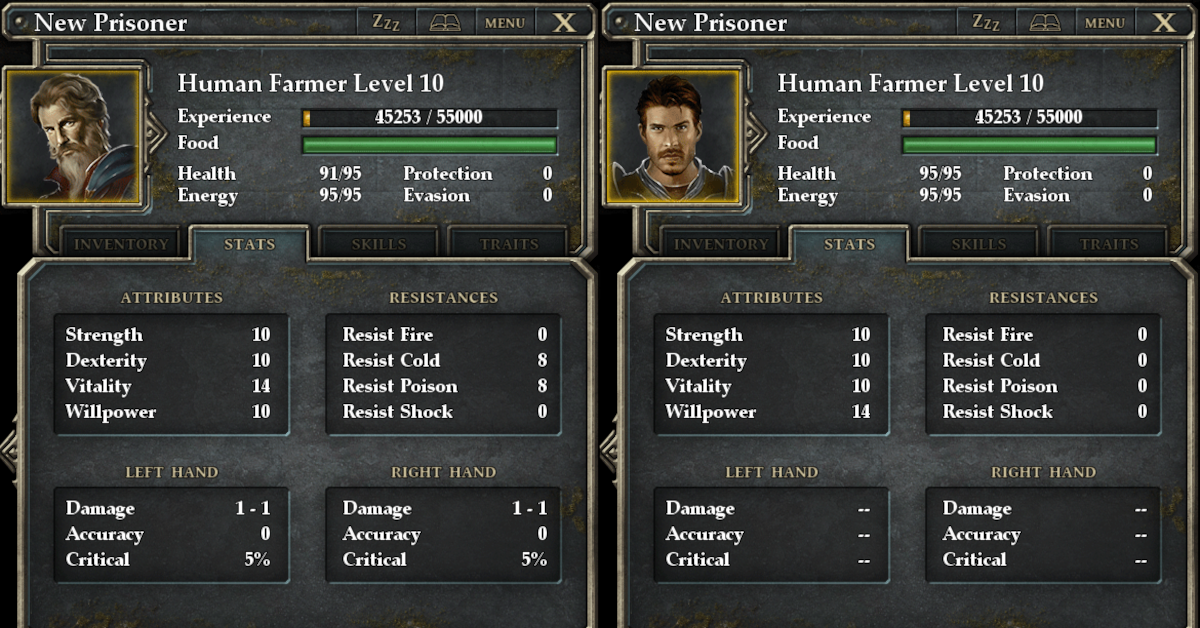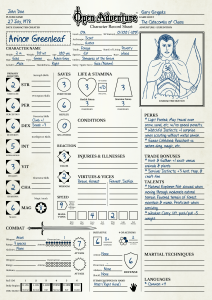Attributes–also known as characteristics, properties, parameters, aspects, or traits–are anything that can describe a distinguishing feature of an object, resource, unit, or avatar (or almost any other game element). In the most basic form, an attribute is used to describe an inherit characteristic of something.
Table of Contents
Anatomy
The structure of an attribute is comprised of a title, value, and unit of measurement. These are most commonly written as “[Title]: [Value] [Unit]”. As an example, “Height: 2 meters” would be an attribute describing an object’s height which has a value of 2 meters. Note that only the title is required, with both the value and unit being optional.
- Title (Required): The name or title of an attribute is a self-descriptive word (or phrase) used to distinguish a feature of the game element that is it attached to. For example, a fantasy creature may have the attribute of “Goblin”, which denotes that it is a goblin.
- Value (Optional): An attribute may have a value attached to its title. Values can showcase a subtype of the parent title or represent a numerical magnitude. For example, a magical effect may have the attribute “Fire: Inferno” showcasing a subtype of the fire attribute. Alternatively, a number can denote a power or intensity (e.g. “Defense: 100”).
- Units (Optional): A value may have a unit of measurement (such as points, length, weight, and so on) attached to its magnitude. For example, a magical bow may have a range attribute denoting a number of meters its arrows can fly before it falls to the ground (e.g. “Range: 7 meters”). As you may have guessed, values and units of measurement are also an attribute.
Purpose
Attributes serve two general purposes: aesthetic descriptions, or functional depictions.
- Aesthetic: Aesthetic attributes are descriptive, thematic, or cosmetic in nature (such as the color of a character’s hair). They serve to add flavor or theme to whatever game element they’re attached to. Aesthetic attributes do not actively affect in-game mechanics or rules.
- Functional: Attributes that have a direct affect on the game can be considered functional (such as a player-character’s “attack score”).
- Characterization: These are core attributes that are fundamental to an avatar, unit, or object. Typically these attributes are permanently-assigned to that unit. This is not to say that the value of the attributes cannot change, but rather that the attribute is mandatory.
- Status: Attributes and modifiers that define the present state of an object or avatar (e.g. its position, speed, condition, etc). These attributes may (or may not) be temporary in nature; and tend to change more frequently than characterization attributes.
Initialization
See the main article.
Duration
See the main article.
Values
- Static: The value of the modifier or attribute is unchanging, remaining at its original value. Note that the characteristic may (or may not) be malleable to outside influences (e.g. a magic spell may be able to alter the static value of a character’s strength attribute).
- Random: The value of the modifier is randomly (or pseudo-randomly) chosen, then applied (e.g. a shield that provides +1d6 defense).
- Variable: The value of the modifier is a variable, which itself is based off another score, ability, event, action, or some other value (e.g. “+5% for every orc you kill”). Modifiers can be whole numbers, fractions, or percentages.
- Progression: The value changes over time (e.g. “+1 for every experience level you gain”). Note that progression values can either be absolute or relative to the point in time that the attribute began.
- Custom: The player can customize the values or abilities of the modifiers. This is either provided as a straight-up “options menu” style where the game allows the player to customize their play experience, or uses a balancing system such as a point-buy (e.g. difficulty modes will increase the HP and offensive power of all the monsters, depending on how much of a challenge the player commits to).
Targets & Exceptions
What category of objects, units, resources, or avatars that an attribute (or modifier) can belong to can vary greatly. Some modifiers may only be used if applied to a certain object, object “type” (see keywords), or condition (which may itself be derived from another game mechanic).
- Targets: Attributes or modifiers may be designated as only targeting units, resources, or avatars of a specific type, sub-type, or with a specific (or group) attribute and modifiers. An example of this is an in-game weapon that will deal +1 damage, but only to units that have a “zombie” attribute assigned to them.
- Exceptions: The inverse of targets are exceptions. Exceptions are to targeting as a blacklist is to a whitelist. With exceptions, an attribute may target all units, resources, objects, or avatars except for those with one (or more) specific (or group of) attribute assigned to them.
Note that targets and exceptions may alter an attribute or modifier in many possible ways: the type, initialization, duration, or value of the character could change depending on the same aspects of the object it is targeting. This is considered an advanced feature, but offers enormous amounts of customization within a game context.

